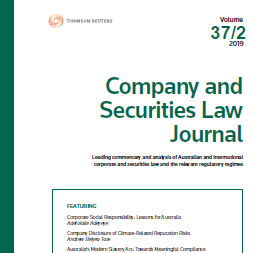*Please note that the links to the content in this Part will direct you to Westlaw AU. If you are using Checkpoint, the links can be found in the Checkpoint PDF at the bottom of this post.
To purchase an article, please email: [email protected] or contact us on 1300 304 195 (Australian customers) or +61 2 8587 7980 (international customers) during business hours (Mon-Fri, 8am-6pm AEST).
The latest issue of the Company and Securities Law Journal (Volume 40 Part 1) contains the following material:
Articles
Selective Disclosures with Minimal Impact – Information Disclosed under Australia’s Modern Slavery Act – Swagota Kotoky and Cary Di Lernia
Australia’s Modern Slavery Act 2018 (Cth) is a disclosure-based approach to assessing and addressing the risks of modern slavery in business operations and supply chains. The provision of easily accessible, accurate disclosures, providing meaningful information could be a valuable opportunity for businesses to present their genuinely slavery-free operations and supply chains to stakeholders including customers, shareholders and employees. This article analyses the disclosures made by the ASX100 in its first year of compliance with the regime. It finds that while businesses appear to be taking various low-level actions to assess and address risks, the provision of accurate and meaningful information requires significant attention from Australia’s most powerful companies if it is to be useful in any real way for report readers, and of any use in addressing the intentions of the Act, and the scourge of modern slavery.
The Diversity of Director Election Rules in Australian National Sporting Organisations – Ian Ramsay and Robert D Macdonald
The authors study the director election rules for 15 leading Australian National Sporting Organisations (NSOs). They identify significant diversity in the director election rules of the NSOs. Based on the number of balloting rounds (whether the NSO has a single ballot or exhaustive ballot voting system), vote weighting, majority voting rules, and whether there is preferential voting, the authors identify 12 different types of director election rules. The authors explore possible reasons for this diversity, observing that all of the different voting rules can be viewed as a form of trade-off between the need to (1) promote efficient collective decision-making in director elections; (2) have voting rules that accurately reflect the preferences of voting members; and (3) in some circumstances allow the interests of certain members to receive greater priority by the use of weighted voting.
COMPANY LAW – Editor: Juliette Overland
- Hakea Holdings Pty Ltd v McGrath (No 2) and the Expanding Tentacles of the Director’s Duty of Care – Dr Elizabeth Boros KC
For the PDF version of the table of contents, click here: New Westlaw Australia – CSLJ Vol 40 No 1 Contents or here: Checkpoint – CSLJ Vol 40 No 1 Contents.
Click here to access this Part on New Westlaw Australia
Click here to access this Part on Checkpoint
For general queries, please contact: [email protected].


